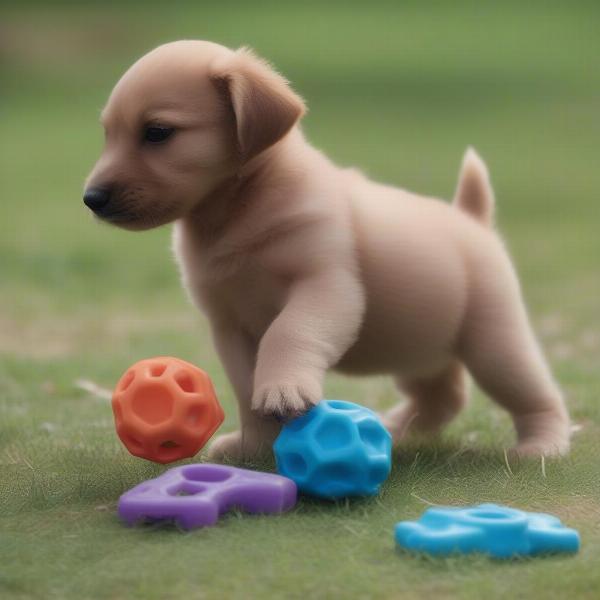Resource guarding, often summarized as “one dog, one bone,” is a common canine behavior where a dog becomes possessive and protective over valued resources. These resources can range from food and toys to sleeping spots and even people. While a mild display of possessiveness might seem harmless, understanding the root causes and implementing appropriate training techniques is crucial to prevent escalation into aggression. This guide delves into the nuances of resource guarding, providing practical advice for dog owners of all experience levels.
Understanding the “One Dog, One Bone” Mentality
The “one dog, one bone” philosophy often stems from a dog’s natural instinct to protect what they perceive as valuable. This behavior isn’t necessarily a sign of dominance or aggression but rather a survival mechanism deeply ingrained in their canine DNA. In the wild, resources are scarce, and protecting food ensures survival. This instinct can carry over into domesticated life, even when resources are plentiful. Understanding this underlying motivation is the first step to addressing resource guarding in your furry friend.
Identifying Resource Guarding in Your Dog
Recognizing the subtle signs of resource guarding is essential for early intervention. While growling, snapping, or biting are obvious signs, other more subtle cues include stiffening, whale eye (showing the whites of their eyes), lip curling, lowering their head over the resource, and rapid eating. Even seemingly innocuous behaviors like yawning, licking their lips, or turning their head away can be signs of stress and potential resource guarding.
Why Do Some Dogs Guard Resources More Than Others?
Several factors contribute to a dog’s propensity to guard resources. Genetics play a role, with some breeds being more predisposed to possessiveness. Past experiences, such as food scarcity in a shelter environment, can also influence this behavior. Additionally, improper socialization during puppyhood can contribute to resource guarding in adult dogs.
Breaking the “One Dog, One Bone” Cycle: Effective Training Techniques
Addressing resource guarding requires patience, consistency, and positive reinforcement. Never punish your dog for guarding. This can escalate the behavior and damage your bond. Instead, focus on desensitization and counter-conditioning.
- Trade-Ups: Offer your dog a higher-value treat in exchange for the guarded resource. This teaches them that your approach isn’t a threat but an opportunity for something better.
- Drop It and Leave It: Practice these commands regularly to build a solid foundation of obedience and impulse control.
- Create Positive Associations: Pair the presence of the valued resource with positive experiences, like praise, petting, or playtime.
- Gradual Desensitization: Slowly introduce yourself to the guarded resource, starting at a distance where your dog shows no signs of guarding. Gradually decrease the distance over time, rewarding calm behavior at each stage.
Preventing Resource Guarding in Puppies
Prevention is always better than cure. Early socialization is key. Expose your puppy to a variety of people, dogs, and environments, ensuring positive interactions around food and toys. Teach them “drop it” and “leave it” from a young age. dog collars with name can also help in identifying each puppy and managing their individual training needs.
 Puppy learning to share toys
Puppy learning to share toys
Conclusion: Moving Beyond “One Dog, One Bone”
Resource guarding is a manageable behavior. By understanding the “one dog, one bone” mentality and implementing proactive training techniques, you can help your dog feel secure and confident, eliminating the need to protect their resources. Remember, patience, consistency, and positive reinforcement are key to building a strong bond with your furry companion and creating a harmonious home environment.
FAQ
- Is resource guarding always a sign of aggression? No, it’s a natural instinct, but it can escalate to aggression if not addressed.
- Can I train an adult dog to stop resource guarding? Yes, with patience and consistent training, adult dogs can learn to relinquish resources without issue.
- What if my dog guards me from other people? Consult a certified professional dog trainer for guidance on addressing this specific type of resource guarding.
- Should I take away my dog’s toys if they guard them? No, this can increase anxiety and worsen the behavior. Focus on positive reinforcement training instead.
- Is it safe to have children around a dog that resource guards? Supervise all interactions between children and a dog that resource guards, and consult a professional if you have concerns.
- What if my dog becomes aggressive when I try to take away the guarded item? Do not attempt to take it away. Consult a certified professional dog trainer immediately.
- Can resource guarding be prevented in puppies? Yes, early socialization and consistent training are crucial for preventing resource guarding.
Related Articles
If you enjoyed this guide on one dog one bone, here are other related articles you may find helpful on our website!
About ILM Dog
ILM Dog is your trusted resource for expert advice on all aspects of dog care, from breed selection and puppy care to senior dog care and behavior training. We’re passionate about helping dog owners around the world provide the best possible care for their furry companions. Our expertise covers everything from nutrition and grooming to health and wellness, ensuring you have the knowledge and tools to nurture a happy and healthy dog. blue dog bandana could be perfect for styling up your furry friend! white dog t shirt may also protect your dog’s fur while going on walks. Whether you’re a new dog owner or a seasoned expert, ILM Dog provides valuable resources to enhance your dog’s life. Contact us today via email at [email protected] or phone at +44 20-3965-8624 for personalized support.